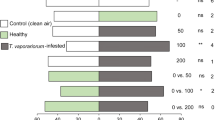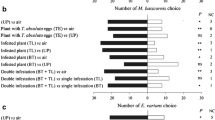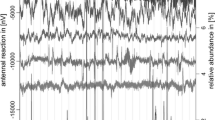Abstract
One of the most damaging insect pests to tomato crops is the tomato leafminer, Tuta absoluta. Current control methods are not efficient at regulating this pest below the economic threshold, leading to the development of new strategies based on its natural enemies. In this study, we evaluated the ability of Macrolophus pygmaeus to discriminate T. absoluta-infested plants versus non-infested tomato plants. We subsequently collected volatile organic chemicals released by tomato plants under different levels of infestation, and identified the associated herbivore-induced plant volatiles (HIPVs). Behavioural assays were conducted in a double-choice olfactometer and flight tunnel. In both systems, M. pygmaeus was significantly attracted towards infested plants. Because distance attraction is likely to be mediated, at least partially, by volatile organic compounds, HIPVs were collected from healthy and infested plants using a dynamic volatile collection system. Volatile chemical profiles vary with the level of infestation; specifically, twice as many chemicals were identified under infestation by 20 T. absoluta larvae compared to healthy plants. A total of 35 compounds were identified, with β-phellandrene, 2-carene, β-caryophyllene, α-pinene and α-phellandrene representing 76–86 % of the total blend. The release of monoterpenes was strongly influenced by the level of caterpillar infestation, while the amount of sesquiterpenes did not vary significantly. We hypothesise that certain HIPVs, most likely monoterpenes, are involved in prey location by M. pygmaeus and have potential to manipulate the natural enemies of T. absoluta to enhance the control of this crop pest.






Similar content being viewed by others
References
Abbas S, Pérez-Hedo M, Colazza S, Urbaneja A (2014) The predatory mirid Dicyphus maroccanus as a new potential biological control agent in tomato crops. Biocontrol 59:565–574. doi:10.1007/s10526-014-9587-6
Acree T, Arn HF (2012) Flavornet: gas chromatography-olfactometry (GCO) of natural products. http://www.flavornet.org/index.html
Adams RP (2009) Identification of essential oil components by gas chromatography/mass spectrometry, 4th edn. Allured publishing corporation, Illinois
Albajes R, Alomar O (2002) Current and potential use of polyphagous predators. In: Rae AL (ed) Integrated pest and disease management in greenhouse crops. Kluwer Academic Publishers, Netherland, p 265
Arab A, Trigo JR, Lourencao AL, Peixoto AM, Ramos F, Bento JM (2007) Differential attractiveness of potato tuber volatiles to Phthorimaea operculella (Gelechiidae) and the predator Orius insidiosus (Anthocoridae). J Chem Ecol 33:1845–1855. doi:10.1007/s10886-007-9358-2
Arimura GI, Kost C, Boland W (2005) Herbivore-induced, indirect plant defences. Biochimica et Biophysica Acta - Molecular and Cell Biology of Lipids 1734:91–111
Arimura GI, Matsui K, Takabayashi J (2009) Chemical and molecular ecology of herbivore-induced plant volatiles: proximate factors and their ultimate functions. Plant Cell Physiol 50:911–923. doi:10.1093/pcp/pcp030
Barnadas I, Gabarra R, Albajes R (1998) Predatory capacity of two mirid bugs on Bemicia tabaci. Entomol Exp Appl 86:215–219
Batalla-Carrera L, Morton A, García-del-Pino F (2010) Efficacy of entomopathogenic nematodes against the tomato leafminer, Tuta absoluta, in laboratory and greenhouse conditions. Biocontrol 55:523–530. doi:10.1007/s10526-010-9284-z
Bawin T, De Backer L, Dujeu D, Legrand P, Caparros Megido R, Francis F, Verheggen FJ (2014) Infestation level influences oviposition site selection in the tomato leafminer Tuta absoluta (Lepidoptera: Gelechiidae). Insects 5:877–884. doi:10.3390/insects5040877
Bawin T et al (2015) Could alternative solanaceous hosts act as refuges for the tomato leafminer, Tuta absoluta? Arthropod-Plant Interact. doi:10.1007/s11829-015-9383-y
Bawin T, Dujeu D, De Backer L, Francis F, Verheggen FJ (in press) Ability of Tuta absoluta (Lepidoptera: Gelechiidae) to develop on alternative host plant species. Can Entomol
Benelli G, Revadi S, Carpita A, Giunti G, Raspi A, Anfora G, Canale A (2013) Behavioral and electrophysiological responses of the parasitic wasp Psyttalia concolor (Szépligeti) (Hymenoptera: Braconidae) to Ceratitis capitata-induced fruit volatiles. Biol Control 64:116–124. doi:10.1016/j.biocontrol.2012.10.010
Biondi A, Desneux N, Siscaro G, Zappalà L (2012a) Using organic-certified rather than synthetic pesticides may not be safer for biological control agents: selectivity and side effects of 14 pesticides on the predator Orius laevigatus. Chemosphere 87:803–812. doi:10.1016/j.chemosphere.2011.12.08210.1111/j.1439-0418.2011.01662.x
Biondi A, Mommaerts V, Smagghe G, Viñuela E, Zappalà L, Desneux N (2012b) The non-target impact of spinosyns on beneficial arthropods. Pest Manag Sci 68:1523–1536. doi:10.1002/ps.3396
Biondi A, Desneux N, Amiens-Desneux E, Siscaro G, Zappalà L (2013a) Biology and developmental strategies of the Palaearctic parasitoid Bracon nigricans (Hymenoptera: Braconidae) on the Neotropical Moth Tuta absoluta (Lepidoptera: Gelechiidae). J Econ Entomol 106:1638–1647. doi:10.1603/ec12518
Biondi A, Zappalà L, Stark JD, Desneux N (2013b) Do biopesticides affect the demographic traits of a parasitoid wasp and its biocontrol services through sublethal effects? PLoS One. doi:10.1371/journal.pone.0076548
Bleeker PM et al (2009) The role of specific tomato volatiles in tomato-whitefly interaction. Plant Physiol 151:925–935. doi:10.1104/pp.109.142661
Bruce TJ, Pickett JA (2007) Plant defence signalling induced by biotic attacks. Curr Opin Plant Biol 10:387–392. doi:10.1016/j.pbi.2007.05.002
Cagnotti CL, Viscarret MM, Riquelme MB, Botto EN, Carabajal LZ, Segura DF, López SN (2012) Effects of X-rays on Tuta absoluta for use in inherited sterility programmes. J Pest Sci 85:413–421. doi:10.1007/s10340-012-0455-9
Caparros Megido R, Haubruge E, Verheggen FJ (2012) First evidence of deuterotokous parthenogenesis in the tomato leafminer, Tuta absoluta (Meyrick) (Lepidoptera: Gelechiidae). J Pest Sci 85:409–412. doi:10.1007/s10340-012-0458-6
Caparros Megido R, Brostaux Y, Haubruge E, Verheggen FJ (2013a) Propensity of the tomato leafminer, Tuta absoluta (Lepidoptera: Gelechiidae), to develop on four potato plant varieties. Am J Potato Res. doi:10.1007/s12230-013-9300-9
Caparros Megido R, Haubruge E, Verheggen FJ (2013b) Pheromone-based management strategies to control the tomato leafminer, Tuta absoluta (Lepidoptera: Gelechiidae) A review. Biotechnol Agron Soc 17:475–482
Caparros Megido R et al (2014) Role of larval host plant experience and solanaceous plant volatile emissions in Tuta absoluta (Lepidoptera: Gelechiidae) host finding behavior. Arthropod Plant Interact. doi:10.1007/s11829-014-9315-2
Castañé C, Alomar O, Goula M, Gabarra R (2004) Colonization of tomato greenhouses by the predatory mirid bugs Macrolophus caliginosus and Dicyphus tamaninii. Biol Control 30:591–597. doi:10.1016/j.biocontrol.2004.02.012
Chailleux A, Bearez P, Pizzol J, Amiens-Desneux E, Ramirez-Romero R, Desneux N (2013) Potential for combined use of parasitoids and generalist predators for biological control of the key invasive tomato pest Tuta absoluta. J Pest Sci 86:541–553
Chamberlain K et al (2001) Can aphid-induced plant signals be transmitted aerially and through the rizosphere? Biochem Syst Ecol 29:1063–1074
Chermiti B, Abbes K (2012) Comparison of pheromone lures used in mass trapping to control the tomato leafminer Tuta absoluta (Meyrick, 1917) in industrial tomato crops in Kairouan (Tunisia). EPPO Bull 42:241–248. doi:10.1111/epp.2561
Cocco A, Deliperi S, Delrio G (2013) Control of Tuta absoluta (Meyrick) (Lepidoptera: Gelechiidae) in greenhouse tomato crops using the mating disruption technique. J Appl Entomol 137:16–28. doi:10.1111/j.1439-0418.2012.01735.x
Colquhoun TA et al (2013) Light modulation of volatile organic compounds from petunia flowers and select fruits. Postharvest Biol Technol 86:37–44. doi:10.1016/j.postharvbio.2013.06.013
De Backer L, Caparros Megido R, Haubruge E, Verheggen F (2014) Macrolophus pygmaeus (Rambur) as an efficient predator of the tomato leafminer Tuta absoluta (Meyrick) in Europe A review. Biotechnol Agron Soc Environ 18:536–543
De Backer L, Wäckers F, Francis F, Verheggen F (2015) Predation of the Peach Aphid Myzus persicae by the mirid Predator Macrolophus pygmaeus on sweet peppers: effect of prey and predator density. Insects 6:514
Degenhardt DC, Refi-Hind S, Stratmann JW, Lincoln DE (2010) Systemin and jasmonic acid regulate constitutive and herbivore-induced systemic volatile emissions in tomato, Solanum lycopersicum. Phytochemistry 71:2024–2037. doi:10.1016/j.phytochem.2010.09.010
Desneux N, Decourtye A, Delpuech JM (2007) The sublethal effects of pesticides on beneficial arthropods. Annu Rev Entomol 52:81–106
Desneux N et al (2010) Biological invasion of European tomato crops by Tuta absoluta: ecology, geographic expansion and prospects for biological control. J Pest Sci 83:197–215. doi:10.1007/s10340-010-0321-6
Desneux N, Luna MG, Guillemaud T, Urbaneja A (2011) The invasive South American tomato pinworm, Tuta absoluta, continues to spread in Afro-Eurasia and beyond: the new threat to tomato world production. J Pest Sci 84:403–408. doi:10.1007/s10340-011-0398-6
Dicke M (2009) Behavioural and community ecology of plants that cry for help. Plant Cell Environ 32:654–665. doi:10.1111/j.1365-3040.2008.01913.x
Dudareva N, Negre F, Nagegowda DA, Orlova I (2006) Plant volatiles: recent advances and future perspectives. Crit Rev Plant Sci 25:417–440
El-Sayed AM (2012) The pherobase: database of pheromones and semiochemicals. http://www.pherobase.com
Farag MA, Paré PW (2002) C6 green leaf volatiles trigger local and systemic VOC emissions in tomato. Phytochemistry 61:545–554
Ferracini C, Ingegno BL, Navone P, Ferrari E, Mosti M, Tavella L, Alma A (2012) Adaptation of indigenous larval parasitoids to Tuta absoluta (Lepidoptera: Gelechiidae) in Italy. J Econ Entomol 105:1311–1319. doi:10.1603/EC11394
Giordanengo P et al (2010) Compatible plant-aphid interactions: how aphids manipulate plant responses. C R Biol 333:516–523. doi:10.1016/j.crvi.2010.03.007
González-Cabrera J, Mollá O, Montón H, Urbaneja A (2010) Efficacy of Bacillus thuringiensis (Berliner) in controlling the tomato borer, Tuta absoluta (Meyrick) (Lepidoptera: Gelechiidae). Biocontrol 56:71–80. doi:10.1007/s10526-010-9310-1
Haddi K et al (2012) Identification of mutations associated with pyrethroid resistance in the voltage-gated sodium channel of the tomato leaf miner (Tuta absoluta). Insect Biochem Mol Biol 42:506–513. doi:10.1016/j.ibmb.2012.03.008
Hassan MN, Alzaïdi S (2009) Tuta absoluta—A serious pest advancing in the Mediterranean region. Role of pheromones in management strategies. Int Pest Control 51:85–87
Ingegno BL, Pansa MG, Tavella L (2011) Plant preference in the zoophytophagous generalist predator Macrolophus pygmaeus (Heteroptera: Miridae). Biol Control 58:174–181. doi:10.1016/j.biocontrol.2011.06.003
Ingegno BL, Ferracini C, Gallinotti D, Alma A, Tavella L (2013) Evaluation of the effectiveness of Dicyphus errans (Wolff) as predator of Tuta absoluta (Meyrick). Biol Control 67:246–252. doi:10.1016/j.biocontrol.2013.08.002
James DG (2005) Further field evaluation of synthetic herbivore-induced plan volatiles as attractants for beneficial insects. J Chem Ecol 31:481–495. doi:10.1007/s10886-005-2020-y
Jansen RMC, Hofstee JW, Wildt J, Verstappen FWA, Bouwmeester HJ, Posthumus MA, van Henten EJ (2008) Health monitoring of plants by their emitter volatiles: trichome damage and cell membrane damaga are detectable at greenhouse scale. Ann Appl Biol 154:441–452. doi:10.1111/j.1744-7348.2008.00311.x
Jennings W, Shibamoto T (1980) Qualitative analysis of flavor and fragrance volatiles by glass capillary gas chromatography. Academic Press, New York
Lietti MMM, Botto E, Alzogaray RA (2005) Insecticide resistance in argentine populations of Tuta absoluta. Neotrop Entomol 34:113–119
Lins JC Jr, van Loon JJA, Bueno VHP, Lucas-Barbosa D, Dicke M, van Lenteren JC (2014) Response of the zoophytophagous predators Macrolophus pygmaeus and Nesidiocoris tenuis to volatiles of uninfested plants and to plants infested by prey or conspecifics. Biocontrol. doi:10.1007/s10526-014-9602-y
Maffei ME (2010) Sites of synthesis, biochemistry and functional role of plant volatiles. S Afr J Bot 76:612–631. doi:10.1016/j.sajb.2010.03.003
Michereff Filho M, Vileda EF, Gulab NJ, Attygalle A, Svatos A, Meinwaldf J (2000) Initial studies of mating disruption of the tomato moth. J Braz Chem Soc 11:621–628
Moayeri HRS, Ashouri A, Brødsgaard HF, Enkegaard A (2006) Odour-mediated preference and prey preference of Macrolophus caliginosus between spider mites and green peach aphids. J Appl Entomol 130:504–508. doi:10.1111/j.1439-0418.2006.01094.x
Moayeri HRS, Ashouri A, Poll L, Enkegaard A (2007) Olfactory response of a predatory mirid to herbivore induced plant volatiles: multiple herbivory vs. single herbivory. J Appl Entomol 131:326–332. doi:10.1111/j.1439-0418.2007.01177.x
Modh Rasdi Z, Fauziah I, Wan Mohamad WAK (2009) Biology of Macrolophus caliginosus (Heteroptera: Miridae) predator of Trialeurodes vaporariorum (Homoptera: Aleyrodidae). Int J Biol 1:63–70
Perdikis D, Kapaxidi E, Papadoulis G (2008) Biological control of insect a mite pests in greenhouse solanaceous crops. Eur J Plant Sci Biotechnol 2:125–144
Proffit M, Birgersson G, Bengtsson M, Reis R Jr, Witzgall P, Lima E (2011) Attraction and oviposition of Tuta absoluta females in response to tomato leaf volatiles. J Chem Ecol 37:565–574
Raghava T, Ravikumar P, Hegde R, Kush A (2010) Spatial and temporal volatile organic compound response of select tomato cultivars to herbivory and mechanical injury. Plant Sci 179:520–526. doi:10.1016/j.plantsci.2010.07.020
Reyes M, Rocha K, Alarcón L, Siegwart M, Sauphanor B (2012) Metabolic mechanisms involved in the resistance of field populations of Tuta absoluta (Meyrick) (Lepidoptera: Gelechiidae) to spinosad. Pestic Biochem Physiol 102:45–50. doi:10.1016/j.pestbp.2011.10.008
Sanchez JA, Spina ML, Perera OP (2012) Analysis of the population structure of Macrolophus pygmaeus (Rambur) (Hemiptera: Miridae) in the Palaearctic region using microsatellite markers. Ecol Evol 2:3145–3159. doi:10.1002/ece3.420
Tropea Garzia G, Siscaro G, Biondi A, Zappalà L (2012) Tuta absoluta, a South American pest of tomato now in the EPPO region: biology, distribution and damage. EPPO Bull 42:205–210. doi:10.1111/epp.2556
Turlings TCJ, Lengwiler UB, Bernasconi ML, Wechsler D (1998) Timing of induced volatile emissions in maize seedlings. Planta 207:146–152. doi:10.1007/s004250050466
Urbaneja A, Gonzalez-Cabrera J, Arno J, Gabarra R (2012) Prospects for the biological control of Tuta absoluta in tomatoes of the Mediterranean basin. Pest Manage Sci 68:1215–1222. doi:10.1002/ps.3344
USDA APHIS (2011) New pest response guidelines: tomato leafminer (Tuta absoluta). United States Department of Agriculture, Washington, DC
Vacas S, Alfaro C, Primo J, Navarro-Llopis V (2011) Studies on the development of a mating disruption system to control the tomato leafminer, Tuta absoluta Povolny (Lepidoptera: Gelechiidae). Pest Manag Sci 67:1473–1480. doi:10.1002/ps.2202
Vercammen J, Pham-Tuan H, Sandra P (2001) Automated dynamic sampling system for the on-line monitoring of biogenic emissions from living organisms. J Chromatogr 930:39–51. doi:10.1016/S0021-9673(01)01172-4
Verheggen F, Fagel Q, Heuskin S, Lognay G, Francis F, Haubruge E (2007) Electrophysiological and behavioral responses of the multicolored asian lady beetle, Harmonia axyridis pallas, to sesquiterpene semiochemicals. J Chem Ecol 33:2148–2155
Verheggen FJ, Arnaud L, Bartram S, Gohy M, Haubruge E (2008) Aphid and plant volatiles induce oviposition in an aphidophagous hoverfly. J Chem Ecol 34:301–307. doi:10.1007/s10886-008-9434-2
Verheggen FJ, Haubruge E, De Moraes CM, Mescher MC (2013) Aphid responses to volatile cues from turnip plants (Brassica rapa) infested with phloem-feeding and chewing herbivores. Arthropod Plant Interact 7:567–577. doi:10.1007/s11829-013-9272-1
Visser JH, Van Straten S, Maarse H (1979) Isolation and identification of volatiles in the foliage of potate, Solanum tuberosum, a host plant of th colorado beetle, Leptinotarse decemlineata. J Chem Ecol 5:13–25
Zappalà L, Siscaro G, Biondi A, Mollá O, González-Cabrera J, Urbaneja A (2012) Efficacy of sulphur on Tuta absoluta and its side effects on the predator Nesidiocoris tenuis. J Appl Entomol 136:401–409. doi:10.1111/j.1439-0418.2011.01662.x
Zappalà L et al (2013) Natural enemies of the South American moth, Tuta absoluta, in Europe, North Africa and Middle East, and their potential use in pest control strategies. J Pest Sci 86:635–647. doi:10.1007/s10340-013-0531-9
Acknowledgments
This study has been supported by a CURAGx grant (Centre universitaire de Recherches agronomiques de Gembloux) and a F.N.R.S. grant (Fonds de la recherche scientifique). The authors would like to thank Félix Wäckers and Dimitri Athanassiou who provided the insects used in this study.
Author information
Authors and Affiliations
Corresponding author
Additional information
Handling Editor: Robert Glinwood.
Electronic supplementary material
Below is the link to the electronic supplementary material.
Rights and permissions
About this article
Cite this article
De Backer, L., Megido, R.C., Fauconnier, ML. et al. Tuta absoluta-induced plant volatiles: attractiveness towards the generalist predator Macrolophus pygmaeus . Arthropod-Plant Interactions 9, 465–476 (2015). https://doi.org/10.1007/s11829-015-9388-6
Received:
Accepted:
Published:
Issue Date:
DOI: https://doi.org/10.1007/s11829-015-9388-6




